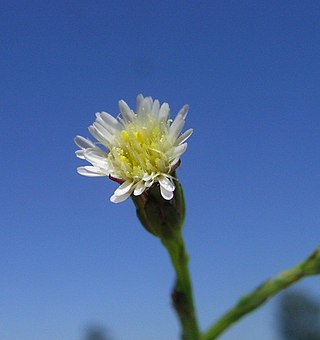
Tiarella, the foamflowers, is a genus of flowering plants in the family Saxifragaceae. The generic name Tiarella means "little turban", which suggests the shape of the seed capsules. Worldwide there are seven species, one each in eastern Asia and western North America, plus five species in eastern North America. As of October 2022, the taxonomy of Tiarella in eastern North America is in flux.
Gundlachia, commonly called goldenshrub, is a genus of flowering plants in the family Asteraceae.

Laennecia or Laënnecia is a genus of flowering plants in the family Asteraceae. The plants are native to Mesoamerica, South America, and the southwestern United States. Common name is "horseweed."
Toiyabea is a genus of North American plants in the tribe Astereae within the family Asteraceae. The genus is named for the Toiyabe Mountains in the US state of Nevada.
Xylothamia, the desert goldenrods, is a formerly accepted genus of flowering plants in the family Asteraceae. Until 2003, it was held to contain nine species of shrubs native to the deserts of Mexico and the southwestern United States. As of May 2024, Plants of the World Online divides the nine former species of Xylothamia among Aquilula, Gundlachia, and Medranoa.
Mexerion is a genus of flowering plants in the tribe Gnaphalieae within the family Asteraceae. As of May 2024, the number of species accepted varies from one to three.

Nardophyllum is a genus of South American flowering plants in the tribe Astereae within the family Asteraceae.

Chrysogonum is a genus of flowering plants in the family Asteraceae. As of May 2024, two circumscriptions of the genus were in use. In the broader circumscription, the genus has a discontinuous distribution, with species native to eastern North America and Madagascar. In the narrower circumscription, the genus contains only species native to eastern North America.
Nardophyllum deserticola is a species of flowering plant in the family Asteraceae, native to Argentina. It was first described in 1953 as Aylacophora deserticola.
Tomentaurum is a genus of Mexican plants in the family Asteraceae. Its species are native to northern Mexico.

Symphyotrichum subulatum, commonly known as eastern annual saltmarsh aster or, in Britain and Ireland where it is naturalized, annual saltmarsh aster, is an annual plant in the family Asteraceae native to the eastern United States and the Gulf Coast to Texas. The species grows primarily in coastal salt marshes, although in the Ozarks it occurs as a non-marine weedy variety.

Symphyotrichum patens, commonly known as late purple aster or spreading aster, is a perennial, herbaceous plant found in the eastern United States.

Symphyotrichum patagonicum is a species of flowering plant in the family Asteraceae endemic to the Argentinian provinces of Chubut, Mendoza, Neuquén, and Santa Cruz. It is an annual, herbaceous plant that grows 3 to 30 centimeters tall. Its flowers have short white ray florets in 3 or 4 series and numerous disk florets.

Symphyotrichum hintonii is a species of perennial, herbaceous, flowering plant in the family Asteraceae native to Guerrero, Mexico. It grows in oak and oak-pine woods at elevations of 1,400–2,200 meters, blooming white ray florets November–January. It reaches heights of about 40–80 centimeters.

Symphyotrichum bimater is a species of flowering plant in the family Asteraceae that is native to the states of Chiapas and Oaxaca in Mexico, and to Guatemala. It is perennial and herbaceous and grows to heights of 30–46 centimeters. Its white ray florets bloom May–December, and it grows in pine-oak woods, ravines, slopes, and grassy openings at elevations 1,000–2,150 meters.

Symphyotrichum chihuahuense is a species of flowering plant in the family Asteraceae that is native to Chihuahua and Durango, Mexico. It is perennial and herbaceous and reaches heights of 20–35 centimeters. Its white ray florets open June–September, and it grows in grasslands and oak–pine woods at elevations 1,800–2,500 meters.

Symphyotrichum purpurascens is a species of flowering plant in the family Asteraceae native to areas of Mexico and Guatemala.

Symphyotrichum turneri is a species of flowering plant in the family Asteraceae native to Durango, Mexico.
Medranoa is a genus of flowering plant in the family Asteraceae, native to northeastern Mexico and Texas. The genus was established in 2004, initially with a single species. It was expanded to five species in 2007, incorporating species formerly placed in Xylothamia, and then in Chihuahuana, Neonesomia, and Xylovirgata.











